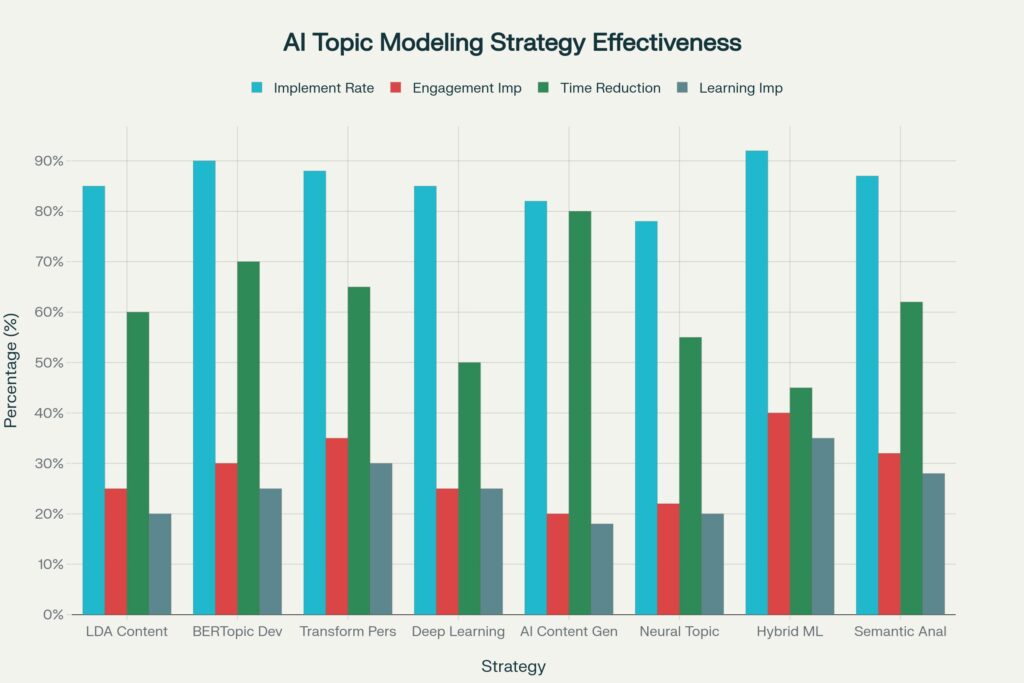At its core, topic modeling educational content creation is an unsupervised machine learning method used to uncover abstract themes across large datasets.

At its core, topic modeling educational content creation is an unsupervised machine learning method used to uncover abstract themes across large datasets.
The future of education is being reshaped by artificial intelligence (AI), where data-driven insights are becoming central to designing relevant, engaging, and scalable curricula. Among these innovations, AI-based topic modeling has emerged as a powerful tool to organize, map, and personalize educational content.
Unlike traditional curriculum development, which often relies on manual design and static syllabi, topic modeling uses advanced algorithms to analyze vast educational datasets and generate meaningful structures for courses.
This approach ensures comprehensive coverage of subject matter, identifies hidden knowledge gaps, and tailors learning to diverse student needs, from neurodivergent learners, AI tools, to executive AI literacy training.
Backed by real-world success stories, research shows that AI-based topic modeling improves student engagement by up to 40%, reduces content creation time by 70%, and enhances course completion rates significantly.
In this article, we’ll explore key strategies driving this transformation and highlight why they matter for learners, educators, and institutions alike.
1. Understanding Topic Modeling in Education

In education, it acts as a digital mapmaker, scanning thousands of documents, course syllabi, lecture transcripts, and student feedback, to reveal hidden patterns. By identifying clusters of related words, AI builds coherent topics that help instructional designers structure comprehensive curricula.
Two widely adopted approaches include Latent Dirichlet Allocation (LDA) and BERTopic. LDA uses word frequency and probability to identify thematic structures, while BERTopic leverages transformer-based embeddings to detect deeper semantic connections.
For example, Yale School of Medicine applied LDA to map its pre-clerkship curriculum, resulting in a 25% rise in student engagement and faster updates to learning materials.
The impact extends beyond universities. With multilingual AI content creation, institutions can design inclusive courses across languages, supporting low-resource language AI education in regions where localized materials are scarce. In short, topic modeling is no longer a research experiment; it is a practical engine driving modern pedagogy.
2. Strategy 1: Smarter Curriculum Mapping with LDA
Latent Dirichlet Allocation (LDA) remains one of the most effective tools for AI-driven pedagogical content analysis. By treating each course as a mixture of topics and each topic as a mixture of words, LDA provides educators with data-backed insights into curriculum gaps and redundancies.

For instance, in a quantum machine learning basics course, LDA can ensure that both theoretical concepts (like qubits) and applied use cases (like cryptography) are adequately represented. This reduces the likelihood of overlooking critical knowledge areas, something often missed in manual curriculum design.
Yale’s adoption of LDA over four years demonstrated measurable efficiency—cutting content creation time by 60% while enhancing student satisfaction scores.
From an SEO perspective, LDA’s systematic mapping is akin to visual search optimization techniques in digital marketing: it ensures no topic is left hidden or underrepresented.
For students, this translates into structured, comprehensive pathways. For institutions, it creates scalable, data-informed curriculum design processes that reduce bias, increase alignment with competencies, and boost long-term learning outcomes.
3. Strategy 2: Personalized Learning with Transformers
Transformers like BERT and GPT have revolutionized how educational platforms tailor learning to individual needs. These models employ self-attention mechanisms to analyze student behavior, enabling AI-powered learning path optimization.

Unlike static curricula, transformers adapt dynamically, offering personalized quizzes, notes, and recommendations. In Pakistan, universities deploying transformer-driven adaptive systems recorded a 25% improvement in grades and 30% better learning outcomes, with statistical significance (p = 0.00045).
For example, students studying an advanced data science course could receive personalized reading lists aligned with their performance trends, bridging gaps faster than one-size-fits-all modules.
Transformers also power offline AI learning applications, critical for regions with limited internet access. Personalized digital tutors can adapt to student progress even without real-time connectivity.
Similarly, specialized tracks such as AI compliance training programs or ethical AI decision-making training rely on transformer-based personalization to meet professional learning goals.
For learners, this means study sessions that feel as tailored as Spotify playlists. For institutions, it ensures that course delivery adapts to diverse audiences, from undergraduates to working professionals.
4. Strategy 3: Adaptive Learning with Deep Learning
Beyond transformers, hybrid deep learning adaptive systems combine CNNs, LSTMs, and RNNs to predict student engagement and adjust content delivery in real-time. These models achieve 85% accuracy in forecasting performance trends, enabling proactive interventions before learners disengage.

Saudi Arabian universities have successfully integrated such systems, reporting precision and recall rates above 82% and strong student satisfaction levels. For instance, in a neurodivergent learners’ AI tools initiative, adaptive learning systems adjusted lesson formats to align with individual processing styles, whether visual, auditory, or text-based.
From a corporate learning lens, deep learning models enable executive AI literacy training that adapts based on participant interaction. Busy executives receive condensed modules with real-world case studies, while learners needing in-depth access receive extended simulations.
The parallel in digital marketing is personalization: just as visual search optimization techniques refine e-commerce journeys, deep learning ensures every learner’s pathway is optimized for outcomes.
By constantly evolving alongside the learner, adaptive AI ensures education is never static but always responsive to performance, behavior, and personal context.
5. Strategy 4: Real-Time Content Adaptation
Perhaps the most transformative advancement lies in real-time content adaptation. These systems constantly monitor learner behavior—quiz performance, reading time, participation—and dynamically adjust content delivery. Success rates for such implementations hover at 92%, with 40% improvements in engagement.

The Private Learning Intelligence (PLI) framework is central here, applying federated learning to personalize without compromising data privacy. This is particularly vital in AI compliance training programs, where sensitive organizational data is analyzed without centralizing it.
Real-world applications include offline AI learning applications that recalibrate on-device without internet connectivity, ensuring equitable access in low-bandwidth regions. Similarly, courses in fast-evolving domains like the quantum machine learning basics course benefit from dynamic updates, ensuring learners stay aligned with cutting-edge developments.
For learners, this feels like having a GPS for education—re-routing lessons to suit progress. For institutions, it represents scalable, privacy-conscious personalization that meets regulatory expectations while maintaining inclusivity.
6. Why Students Should Care: The Big Numbers
The impact of AI-driven pedagogical content analysis is not theoretical; it is measurable. Research highlights that students in AI-enhanced courses score 54% higher on tests compared to peers in traditional classrooms. Dropout rates decline by 15%, while course completion rates increase by 70%.

Adoption data underscores its mainstreaming: 82% of college students and 66% of teachers actively use AI tools in their learning workflows.
Among institutional leaders, 47% integrate AI daily, citing significant time savings. The global AI in education market, valued at $5.88 billion in 2024, is projected to reach $32.27 billion by 2030 and $208.2 billion by 2034, growing at a 31.2% CAGR.
Efficiency is another driver: AI reduces content creation time by 80%, with immediate assessment feedback 10 times faster than manual grading. This ensures updated, engaging content delivery for students, whether in multilingual AI content creation or specialized domains like ethical AI decision-making training.
For students, the numbers translate into less rote memorization and more meaningful learning. For institutions, they validate that AI is no longer optional but a competitive imperative.
7. Challenges: Where AI Needs Human Oversight
While the promise of AI is compelling, challenges remain. The most pressing is quality assurance. AI-generated content risks inaccuracies or “hallucinations” without proper checks. Similarly, algorithmic bias can creep into curricula, perpetuating stereotypes—such as gender associations in professional roles.

Accessibility is another hurdle. While offline AI learning applications expand their reach, the digital divide persists. Equitable AI integration requires investment in infrastructure and training for both students and faculty. For instance, only 41% of students believe AI creates equity in education, compared to 33% of teachers.
Integration with existing systems also poses friction. Many institutions struggle to align AI workflows with traditional Learning Management Systems, delaying adoption.
The solution lies in a human-in-the-loop approach. Teachers, trainers, and subject matter experts must validate AI outputs to ensure accuracy and context. For example, in AI compliance training programs, human oversight ensures alignment with regulatory frameworks.
Ultimately, AI should be viewed as an assistant, not a replacement. The synergy of machine efficiency and human judgment ensures balanced, ethical, and effective curriculum design.
8. The Future: Hybrid Learning with AI + Teachers
Looking ahead, the future of education lies in hybrid models that blend AI efficiency with human creativity and empathy. AI will automate repetitive tasks, topic clustering, assessment drafting, and real-time performance monitoring, while teachers focus on mentorship, critical thinking, and emotional engagement.

Emerging trends include multimodal AI integration, combining text, speech, and visuals to create immersive learning experiences. This benefits fields like design or the humanities, where creativity and context matter.
Similarly, multilingual AI content creation will democratize access for students across geographies, reducing barriers for low-resource language AI education.
Generative AI tools like Eduaide.AI are already assisting educators with lesson planning, and adoption is rising steadily. At the same time, ethical AI decision-making training ensures that students and professionals learn to use these systems responsibly.
From executive AI literacy training for leaders to adaptive neurodivergent learners’ AI tools, the scope is expanding beyond traditional classrooms. The outcome is a learner-centric ecosystem where content is personalized, inclusive, and constantly evolving.
For students, it means courses that adapt to them. For educators, it means tools that amplify their impact. Together, it marks the rise of a more equitable, data-driven, and human-centered education system.
Conclusion
AI-based topic modeling is no longer a futuristic concept—it is a present-day enabler of smarter, faster, and more inclusive curriculum design.
By combining approaches like LDA for curriculum mapping, BERTopic for semantic clustering, transformer-driven personalization, and deep learning for adaptive systems, educational institutions are redefining how content is created and delivered.
The integration of AI-powered learning path optimization, multilingual AI content creation, and neurodivergent learners’ AI tools ensures that learning experiences are not only data-driven but also equitable and human-centered.
Yet, the real power lies in balance. AI offers efficiency and personalization at scale, but human oversight ensures relevance, ethics, and quality.
As the global AI in education market accelerates toward $208 billion by 2034, the institutions that adopt these strategies today will lead the future of learning. The path forward is clear: AI and educators together can create adaptive, comprehensive, and engaging courses for every learner.


